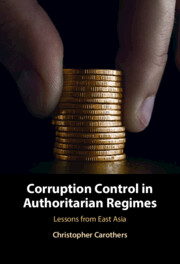Book contents
- Corruption Control in Authoritarian Regimes
- Corruption Control in Authoritarian Regimes
- Copyright page
- Contents
- Figures
- Tables
- Acknowledgments
- 1 Introduction
- 2 Theory and Methodology
- 3 How the Kuomintang Cleaned House in Taiwan
- 4 Corruption Control in Authoritarian South Korea
- 5 The Chinese Communist Party’s War against Corruption, 1921–1990
- 6 Xi Jinping’s Campaign and the End of Political Liberalization
- 7 Anti-corruption Efforts around the Authoritarian World
- 8 Conclusion
- Book part
- Bibliography
- Index
4 - Corruption Control in Authoritarian South Korea
Published online by Cambridge University Press: 31 March 2022
- Corruption Control in Authoritarian Regimes
- Corruption Control in Authoritarian Regimes
- Copyright page
- Contents
- Figures
- Tables
- Acknowledgments
- 1 Introduction
- 2 Theory and Methodology
- 3 How the Kuomintang Cleaned House in Taiwan
- 4 Corruption Control in Authoritarian South Korea
- 5 The Chinese Communist Party’s War against Corruption, 1921–1990
- 6 Xi Jinping’s Campaign and the End of Political Liberalization
- 7 Anti-corruption Efforts around the Authoritarian World
- 8 Conclusion
- Book part
- Bibliography
- Index
Summary
Chapter 4 assesses corruption control efforts by South Korea’s military-back authoritarian governments between the 1960s and 1980s. I argue that Park Chung-hee was a motivated reformer and had sufficient state capacity at his disposal but initially faced too many constraints on his leadership to curb corruption. Park came to power in a coup in 1961 and, as promised, launched a crackdown on corrupt politicians and businesspeople. However, Park had to contend with quasi-democratic institutions, powerful private economic actors, and other factors that made following through on anti-corruption reforms politically infeasible. This changed after Park consolidated personal power in the early 1970s, especially through the passage of the repressive Yushin constitution in 1972. Park was able to enact the General Administrative Reform (1973–77) to reduce corruption and strengthen South Korea’s developmental state. This chapter also discusses Chun Doo-hwan’s Purification campaign (1980–81), which was a more typical case of superficial anti-corruption efforts by an autocrat motivated by narrowly political considerations.
Keywords
- Type
- Chapter
- Information
- Corruption Control in Authoritarian RegimesLessons from East Asia, pp. 90 - 130Publisher: Cambridge University PressPrint publication year: 2022



